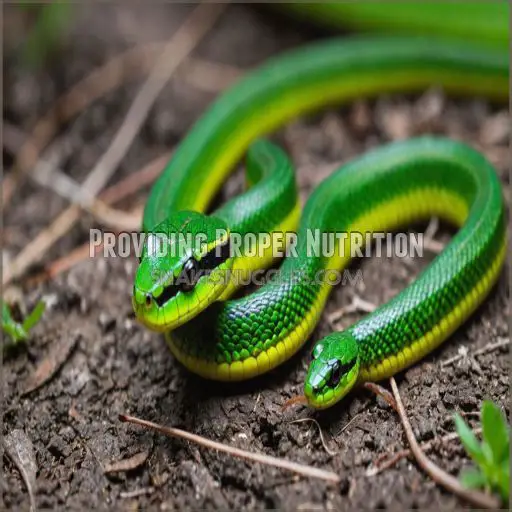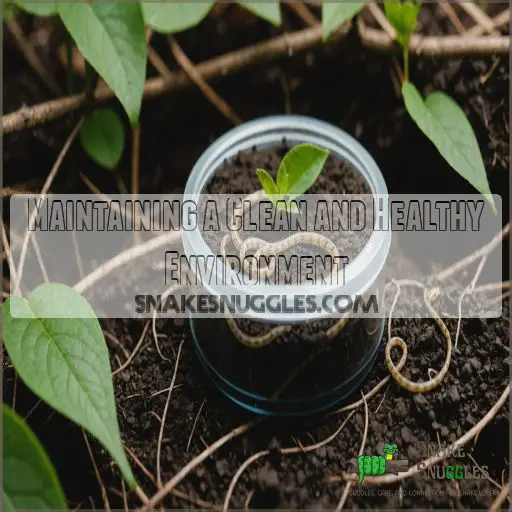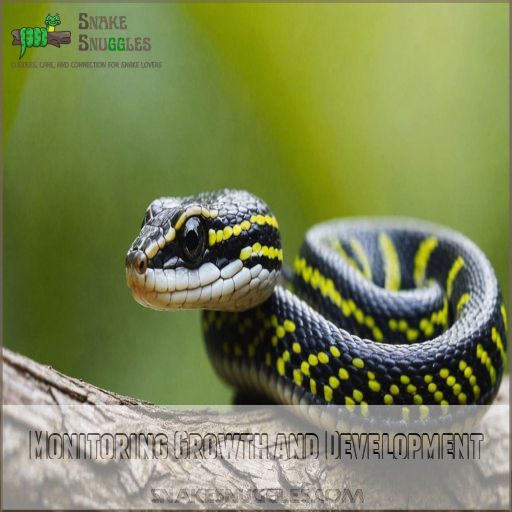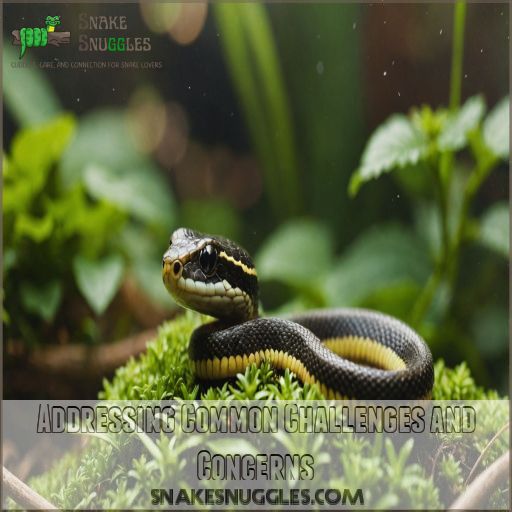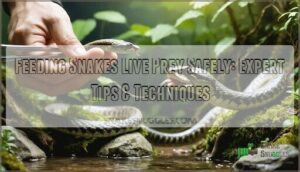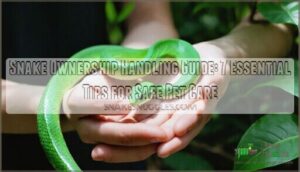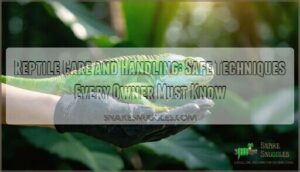This site is supported by our readers. We may earn a commission, at no cost to you, if you purchase through links.
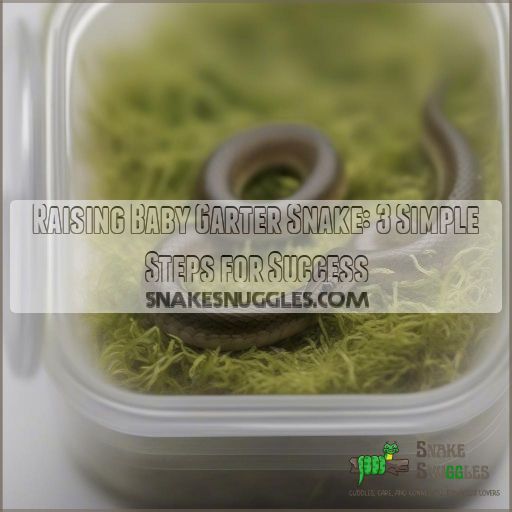 Raising a baby garter snake is easier than you think! The key is to follow three simple steps: First, choose the right species that fits your lifestyle and home. Research their unique needs to set up a cozy, safe habitat.
Raising a baby garter snake is easier than you think! The key is to follow three simple steps: First, choose the right species that fits your lifestyle and home. Research their unique needs to set up a cozy, safe habitat.
Next, nail the nutrition – feed the right prey at the right frequency to keep your slithery friend healthy and growing.
Table Of Contents
- Key Takeaways
- Choosing the Right Garter Snake
- Setting Up a Safe Environment
- Providing Proper Nutrition
- Maintaining a Clean and Healthy Environment
- Handling and Socializing Your Baby Garter Snake
- Monitoring Growth and Development
- Addressing Common Challenges and Concerns
- Long-Term Care and Considerations
- Frequently Asked Questions (FAQs)
- How to take care of a garter snake for beginners?
- How to raise a baby garter snake?
- What do baby garter snakes need?
- How long does it take for a baby garter snake to grow?
- How often should I feed my baby garter snake?
- What temperature range is ideal for garter snakes?
- Can baby garter snakes be housed together safely?
- How do I know if my garter snake is shedding?
- When should I start handling my baby garter snake?
- Conclusion
Key Takeaways
- You’ll want to choose the right garter snake species for your lifestyle and space. Think of it like finding the perfect roommate—you need one that fits your vibe and won’t outgrow your pad too quickly.
- Set up a cozy snake paradise with the right temperature gradient, humidity levels, and hiding spots. It’s like creating a five-star resort for your scaly friend, complete with a warm basking area and a cool retreat.
- Nail the nutrition by offering a varied diet of earthworms, fish, and eventually mice. Remember, you’re not just feeding a snake—you’re cultivating a gourmet palate that’ll make your reptile the envy of the neighborhood.
- Handle your baby garter snake gently and regularly to build trust and socialization, understanding their temperament. It’s like teaching a tiny, legless puppy to be comfortable with you—start slow, be patient, and soon you’ll have a slithery BFF.
Choosing the Right Garter Snake
Choosing the right garter snake is really important for a successful pet-keeping experience.
Research different species, select a healthy baby, and understand the unique needs of your chosen snake – these simple steps will set you up for a rewarding journey with your new slithery companion.
Researching Different Species of Garter Snakes
If you’re thinking about getting a garter snake, knowing the different species helps. Here’s a quick guide:
- Garter snake temperament
- Garter snake lifespan
- Garter snake diet
- Garter snake habitat
Selecting a Healthy Baby Garter Snake
Choosing the right garter snake involves checking its health, temperament, and genetics. Look for clear eyes, vibrant color, and active behavior. Remember, a healthy snake is your perfect escape artist!
Understanding the Needs of Your Chosen Species
Understanding your chosen species’ needs is really important.
Garter snakes have unique housing requirements, diet preferences, and temperament variations.
Embrace snake husbandry with humor, ensuring good reptile care through proper enclosures, diet, and temperature.
Preparing for the Arrival of Your Baby Garter Snake
Excited to welcome your new baby garter snake? First, research different species to find the perfect fit. Then, gather essential supplies like the right-sized tank, substrate, and hiding spots. With the right setup, your new scaly friend will thrive!
- Research Garter Snake Species
- Gather Necessary Supplies
- Create a Safe, Comfortable Home
- Set Realistic Expectations
Setting Up a Safe Environment
Creating a safe environment for your baby garter snake is like setting up a tiny reptilian paradise, with just the right balance of warmth and humidity.
Don’t worry, it’s easier than herding cats, and your snake will thank you with happy slithers!
Choosing the Best Substrate for a Baby Garter Snake
Leaping into substrate options can make or break your baby garter snake’s comfort.
Opt for paper towels, cypress mulch, or bark nuggets.
Maintain proper moisture levels, just like baby snakes need their cozy carpets.
Creating a Temperature Gradient in the Enclosure
Once you’ve picked a comfy substrate, make sure your baby garter snake can enjoy a warm soak on one side of the tank using heat mats.
Temperature monitoring makes sure gradient benefits and comfort.
Providing a Humidity Gradient and a Moist Spot
Maintaining the right humidity is important for baby garter snakes.
Provide a moisture gradient with a moist spot, like sphagnum moss, to prevent dehydration and blister disease.
This setup keeps your slithery friend happy and healthy.
- Create a humidity gradient
- Include a moist hiding spot
- Monitor for signs of dehydration
- Avoid excess moisture in the enclosure
Ensuring Proper Ventilation and Lighting
Much like Goldilocks finding the perfect porridge, your garter snake needs balanced ventilation and lighting for a comfortable habitat.
Make sure there’s ample airflow for humidity control.
Using a cage size that accommodates growth.
Providing Proper Nutrition
Feeding your baby garter snake properly is essential for its growth, but figuring out what they’ll eat can sometimes feel like deciphering a mystery.
Start with earthworms and fish to get them interested, but don’t be afraid to try turning these picky eaters into mouse fans for a balanced diet.
Understanding the Dietary Needs of a Baby Garter Snake
After setting up their environment, feed your baby garter snake small fish or insects. Monitor feeding frequency to prevent picky eating and keep them healthy.
Offering Live or Frozen-Thawed Prey Items
Wondering what prey items to offer? Live or frozen-thawed mice, rats, or fish make excellent, nutritious meals for your growing baby garter snake.
Feeding Earthworms and Fish to Baby Garter Snakes
Secure worm availability and fish sourcing for your garter snake’s diet for proper feeding. Feed frequently, ensuring worm safety to minimize parasite risk. Balance is important, happy feeding!
Converting to a Mouse-Based Diet for Better Nutrition
Once you’re done with earthworms, mouse-based diets offer great nutrition. Pinkies boost growth rates, lower parasite risks, and make feeding your snake a breeze.
Avoiding Internal Parasites and Ensuring Proper Hydration
Think of parasites as pesky hitchhikers! Offer parasite-free food and maintain good humidity levels. For hydration, provide clean water sources and monitor enclosure setup diligently.
Maintaining a Clean and Healthy Environment
Maintaining a clean and healthy environment is really important for the well-being of your baby garter snake.
By regularly cleaning the enclosure, monitoring for signs of illness, and ensuring proper humidity levels, you can create a safe and thriving home for your slithery companion.
Cleaning the Enclosure and Replacing Substrate
Feeding time’s over, let’s make sure a clean, cozy habitat for your snake.
- Use aspen or paper towels as substrate.
- Clean weekly, removing waste with a scoop.
- Maintain hygiene by replacing substrate regularly.
Monitoring for Signs of Disease and Illness
Keep an eagle eye on your snake’s health.
Watch for signs like shedding issues, respiratory problems, or eye infections.
Unusual behavior might indicate parasites, so act promptly to protect your snake’s well-being.
Quarantining New Snakes and Prey Items
When bringing new snakes or prey home, quarantine them for a few weeks.
This practice helps prevent disease transmission and parasite infestations,
ensuring a safe, healthy environment for your slithery companions.
Ensuring Proper Hydration and Humidity Levels
To keep your baby garter snake hydrated, mist the enclosure daily and provide a shallow water bowl.
Choose an absorbent substrate and monitor humidity levels with a gauge for their comfort.
Handling and Socializing Your Baby Garter Snake
Discovering the right way to handle and socialize your baby garter snake is an important part of creating a trusting bond.
With safe handling techniques and gentle interactions, you’ll soon find your slithery friend is surprisingly charming—just don’t let them charm their way out of your hand!
Understanding the Temperament of Your Baby Garter Snake
A clean environment supports your baby garter snake’s healthy temperament. They’re naturally curious but can show initial shyness or slight aggression.
Watch for:
- Activity levels
- Socialization cues
- Responses to stimuli
- Signs of stress
- Interaction frequency
Handling Your Baby Garter Snake Safely and Gently
Handling gently minimizes stress on your garter snake—think of it as a soothing lullaby rather than a wrestling match!
Make sure you restrain the snake safely by supporting both ends, and avoid overwhelming the snake, staying mindful of stress signs like rapid tongue flicking.
Socializing Your Baby Garter Snake for Better Handling
Socializing your baby garter snake early on is key – start with brief, gentle handling sessions and gradually increase duration.
Use positive reinforcement to build trust, and always prioritize the snake’s comfort and safety during interactions.
Monitoring Growth and Development
Keeping tabs on your baby garter snake’s growth is key to ensuring they’re healthy and happy—nothing more satisfying than watching them outgrow their little tank!
Don’t forget, even snakes have growing pains, so be ready to adjust their food and environment to fit their ever-growing needs.
Measuring and Weighing Your Baby Garter Snake
After gentle handling, track your snake’s growth using accurate tools. Here’s a simple plan:
- Measure weekly.
- Record in growth charts.
- Use different tools for accuracy.
- Celebrate small milestones!
Monitoring Shedding and Growth Patterns
After measuring and weighing, keep an eye on shedding frequency and growth rate.
Garter snake growth is like a teen’s pants—they outgrow them quickly.
Monitor size changes and weight tracking for healthy development.
Recognizing Signs of Illness or Disease
Keep a close eye on your baby garter snake’s droppings, weight, energy levels, and shedding. Any changes in appetite or lethargy could signal an underlying health issue needing prompt attention.
Adjusting Feeding and Environmental Conditions as Needed
As you spot signs of illness, begin adjusting feeding schedules and environmental conditions.
Prioritize temperature regulation, humidity control, and regular substrate changes.
Consistently monitor growth to make sure your baby garter snake thrives.
Addressing Common Challenges and Concerns
Raising baby garter snakes can be both rewarding and challenging, but don’t worry; addressing these common concerns is easier than you might think!
From feeding hiccups to escape artist antics, this section helps your slippery friend stay happy and healthy.
Dealing With Feeding Issues and Refusal to Eat
Why’s your baby garter snake being a fussy eater? Sometimes, prey recognition issues arise.
Try offering variety.
Diet conversion might help.
Avoid forced feeding.
Patience and experimentation can tackle this picky predicament!
Managing Escapes and Ensuring a Secure Enclosure
Garter snakes are notorious escape artists, so securing their enclosure is really important.
Follow these 4 tips to prevent escapes:
- Use a tight-fitting lid,
- Make sure there’s proper ventilation,
- Choose the right substrate, and
- Provide an adequately sized home.
Preventing and Treating Common Health Issues
Make sure escapes are prevented by focusing on health issues like blister disease and shedding problems. Treat dehydration promptly. Use the table below to detect and manage these common concerns.
| Issue | Prevention Method | Treatment Strategy |
|---|---|---|
| Parasite | Regular vet checks | Antiparasitic medication |
| Dehydration | Humidity control | Moisture supplement |
| Blister Disease | Proper sanitation | Antibiotic ointment |
| Shedding Problems | Humidity adjustment | Warm water soak |
| Fungal Infections | Enclosure cleaning | Antifungal treatment |
Addressing Concerns About Handling and Temperament
Got a snake nervous as a long-tailed cat in a room full of rocking chairs?
Gently handle your garter snake regularly to nurture a calm temperament and prevent bites.
Socialization matters!
Long-Term Care and Considerations
You’ve successfully cared for your baby garter snake, but now it’s time to think long-term, like upgrading that tiny snake apartment to a penthouse suite!
Keep your snake thriving by continuing to provide excellent nutrition.
Consider whether your little wriggler might be ready for starting a family of its own someday.
Upgrading Enclosures and Equipment as Needed
As your baby garter snake grows, you’ll need to upsize their home.
Swap out that starter tank for a larger 15-gallon abode – they’ll appreciate the extra wiggle room!
Don’t forget to upgrade their heating and hiding spots too.
Continuing to Provide Proper Nutrition and Care
When it comes to long-term care, establish a reliable feeding schedule, focus on water quality, and consider supplements to help your pet stay healthy.
With humor and care:
- Keep the menu fresh.
- Maintain a pristine habitat.
- Check for sneaky symptoms.
Considering Breeding and Reproduction Options
Venturing into breeding garter snakes? Choose a well-matched pair and observe their mating behavior.
During the breeding season, patience is key.
With a gestation period of two and a half months, plan hatchling care to make sure a smooth birthing process.
Frequently Asked Questions (FAQs)
How to take care of a garter snake for beginners?
You’ll need a spacious enclosure with proper heating, hiding spots, and a water dish.
Feed your garter snake small fish or worms.
Handle gently and regularly.
Keep the habitat clean and monitor your slithery friend’s health closely.
How to raise a baby garter snake?
Ready to raise a baby garter snake? It’s simpler than you’d think!
Provide a cozy home with proper humidity.
Offer small prey like worms or fish parts, and consider group housing.
Don’t forget a temperature gradient for good health.
What do baby garter snakes need?
Baby garter snakes need a proper enclosure with a humidity gradient, a suitable substrate like paper towels, and a varied diet.
You’ll want to provide a moist spot, maintain correct temperatures, and offer appropriate-sized food items regularly.
How long does it take for a baby garter snake to grow?
Garter snakes grow rapidly, reaching adult size in about 3-4 years.
You’ll see noticeable growth within months, but it’s a gradual process.
Keep tracking their length and weight to monitor their progress.
It’s like watching a living tape measure!
How often should I feed my baby garter snake?
You’ll want to feed your baby garter snake every 2-3 days.
Their tiny tummies need frequent meals!
Offer small portions of worms, fish, or pinky parts.
Keep an eye out – they’re growing fast and always hungry!
What temperature range is ideal for garter snakes?
Like a cozy cocoon, your garter snake’s enclosure should provide a temperature gradient.
Keep one side at 75-85°F (24-29°C) and the other cooler.
This allows your slithery friend to regulate its body temperature effectively.
Can baby garter snakes be housed together safely?
Yes, you can safely house baby garter snakes together.
They’re social creatures and often thrive in groups.
Just keep an eye on feeding time to avoid squabbles, and make sure there’s enough space for everyone to slither comfortably.
How do I know if my garter snake is shedding?
Watch for telltale signs: your garter snake’s eyes may turn bluish-white, its skin might appear dull or wrinkly, and it could become less active.
Don’t panic if you miss the actual shedding – it happens quickly!
When should I start handling my baby garter snake?
Time flies when you’re raising a baby garter snake!
You can start gentle handling after about two weeks.
Keep sessions short at first, 5-10 minutes max.
Gradually increase duration as your snake gets comfortable with you.
Conclusion
They say, "Good things come in small packages," and that’s certainly true for raising a baby garter snake in 3 really simple steps.
By choosing the right species, setting up a safe environment, and providing proper nutrition, you’re on the path to success.
Enjoy the fascinating journey of watching your slithery friend thrive.



